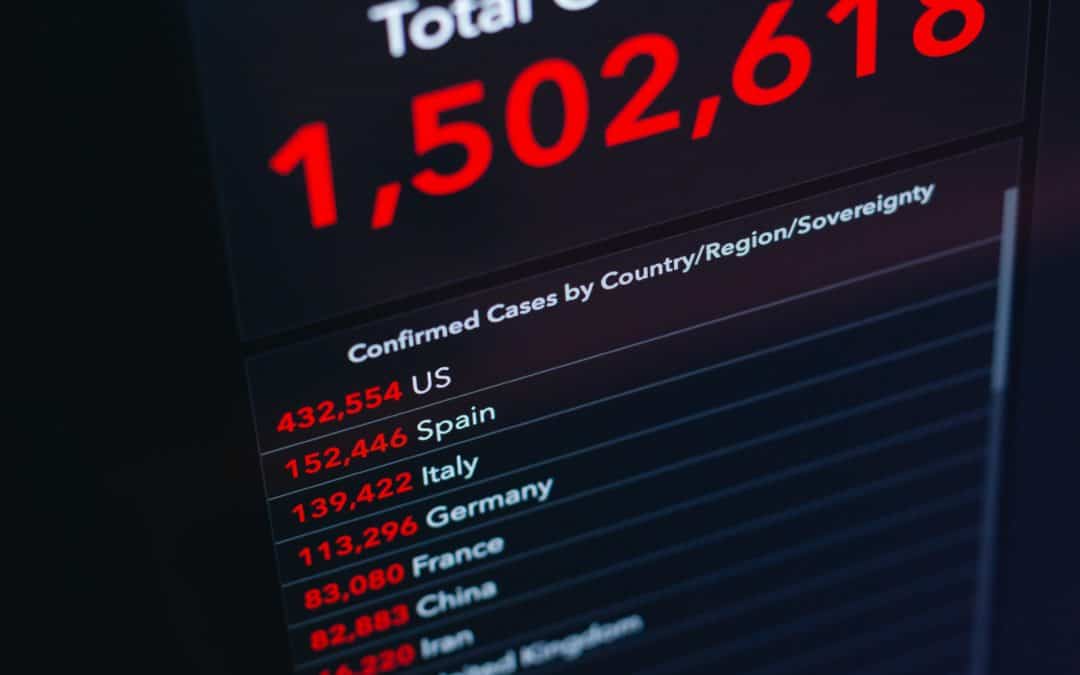
The Impact of COVID-19 on U.S. Hospital Pharmacies
 The New England Journal of Medicine reported the first case of the novel coronavirus was confirmed in the United States in January 2020. This means that as of late July, there has been more than six months of sustained uncertainty and instability. We’ve likely all been impacted by COVID-19 in one way or another. Arguably, no one has been more affected than the healthcare workers risking their lives on the front lines every day to care for our loved ones while isolating from their own.
The New England Journal of Medicine reported the first case of the novel coronavirus was confirmed in the United States in January 2020. This means that as of late July, there has been more than six months of sustained uncertainty and instability. We’ve likely all been impacted by COVID-19 in one way or another. Arguably, no one has been more affected than the healthcare workers risking their lives on the front lines every day to care for our loved ones while isolating from their own.
Along with this global pandemic came a wave of fear over the shortage of drugs, be it from supply chain issues or general population hoarding “potential cures” for COVID-19. Over the last 19 years, the American Society of Health-System Pharmacists (ASHP) reports an average of 143 new national drug shortages per year. As of July 20, ASHP is reporting that there is a current shortage of 209 drugs. With the large number of COVID-19 cases, we are battling with shortages of medications that include propofol, fentanyl, and hydroxychloroquine.
To find out how hospital pharmacies are being impacted by COVID-19 so we can share best practices and advice, we reached out to a few of our clients. In this Q&A, we interviewed Meghan, the pharmacy buyer at a large teaching hospital in the Northeast; Kristin, the pharmacy manager at Froedtert Hospital in Milwaukee; and Brian, the Assistant Manager of Pharmacy – Medication Utilization Strategy at University of Virginia Medical Center.
How has your pharmacy team been affected by COVID-19?
Meghan: There have been so many changes to our department affecting so many interdisciplinary teams. A good portion of the team have adjusted their schedules to help out where necessary. There are team members working from home, which is an adjustment. We have staff working in different areas than they are used to. The COVID-19 pandemic has really shown how flexible, talented, and dedicated our department is to our patients.
Kristin: In an effort to remain effective and due to low census, we’ve modified the number of hours staffed and some individuals are now working from home.
Brian: COVID-19 has presented unique challenges. Like many, we’ve learned how to communicate virtually. However, we’ve also seen more shortages of critical drugs at a time when we were already seeing increased usage.
How has COVID-19 affected the state of shortages at your organization?
Meghan: We’ve found the entire drug supply chain to be stressed. We’ve seen some older shortages that we thought were resolving rear their ugly head again (e.g., injectable opioids, IV fluids, heparin). In these instances, we already had plans of action that we could enact. However, COVID-19 has made some of these shortages more severe. We have usage rates that skyrocketed across the system—way over what was previously forecasted. This type of activity creates somewhat of a “perfect storm” where the wholesaler is unable to keep up with our demand, which then carries over to the manufacturer. Fortunately, we started to plan in advance of this pandemic, prioritizing and conserving critical items before we reached the peak.
Kristin: COVID-19 has impacted the quantities available for purchase of products used to treat patients with the virus. Many products have been placed on protective allocations, and we’ve been monitoring these products very closely for on-hand supply. We have also had much more interest in our shortage management process from individuals and disciplines not normally involved.
Brian: There have been more shortages than usual. Some have been more long-term, and many have been temporary. We have also seen challenges in being able to order products since our wholesaler has implemented restrictions to prevent over buying.
How long did it take before you started seeing shortages and what drugs are you seeing major shortages of (example: hydroxychloroquine)?
Meghan: We started seeing shortages almost immediately. We were proactive in adding medications into OrbitalRX so that we would be monitoring them ahead of time and be able to catch trends in our supplies. Some specific medications we’re seeing large declines in are propofol, hydroxychloroquine, cisatracurium, rocuronium, vecuronium, and large volume IV opioids.
Kristin: We started seeing shortages within days of news stories being released and new data emerging. In particular, propofol, Precedex, Nimbex, famotidine, and dexamethasone were the most heavily impacted.
Brian: We began seeing shortages in late February. As the pandemic worsened, many hospitals began purchasing supplies to prepare leading to stress on the supply chain. We have seen significant shortages with metered dose inhalers, opioids, sedation, paralytics and many other critical care drugs. We also saw fluctuating supply of several products that were reported as potential therapeutic options such as hydroxychloroquine, azithromycin, famotidine, and dexamethasone.
How are the shortages impacting non-COVID patients?
Meghan: We’ve implemented restrictions on certain drugs to try to hold that drug supply specific for COVID patients where clinically appropriate. For the most part, we’ve been successful in managing our shortages to the point where there has been little to no impact on non-COVID-19 patients.
Kristin: Fortunately, we’ve been able to maintain supply of all products, so there has been minimal impact for us. We haven’t needed to implement therapeutic interchanges or restrict use to certain populations as of yet.
Brian: Early in the pandemic, many hospitals saw decreases in elective procedures and admissions. Thankfully this allowed us to reserve stock. However, many patients who required critical care were still admitted. For example, we had to work closely with our providers and frontline pharmacy staff to switch between opioids weekly to ensure we had enough of each product when it was most clinically appropriate to use.
Are you experiencing shortages of drugs used to ventilate patients, such as propofol, fentanyl, and morphine?
Meghan: Yes, we saw the biggest hit at the beginning of April, but as of late April/early May, we have a good in-house supply of these items and have a plan in place to move forward in the event these remain in short supply.
Kristin: Yes, these are some of the most impacted products. Many manufacturers have responded by allowing us to purchase directly through them.
Brian: We have seen significant shortages with these agents. Just about any agent used to treat patients with refractory ARDS have been limited. Including those mentioned, we have also seen shortages with paralytics and sedatives such as dexmedetomidine and midazolam.
What adjustments have been made by your team in response to the pandemic?
Meghan: Pharmacy leadership meets multiple times a week as we continue to navigate our way through the health crisis. Our team has been incredibly proactive in preparation. Now that we’re hopefully at the peak, we’re able to project how long our drug supply will last us and determine and predict which items will have the largest impact on our patients. As a pharmacy department, we’re routinely reviewing drug usage and trends in usage so we can quickly pivot when needed.
Kristin: We’ve been closely monitoring specific medications across the system and allocating product to sites as necessary. We’ve also increased buying specific drugs we knew may be used heavily if our COVID-19 volumes increased. We’ve also purchased non-preferred concentrations and vial sizes in order to continue meeting our patients’ needs. Lastly, we’ve increased shift coverage for management of incoming stock and product purchasing.
Brian: We’ve increased our communication and developed strategies for real-time utilization so we can stay on top of any challenges that arise.
What advice can you share with other hospital pharmacies about how to prepare or adjust their strategies?
Meghan: Be flexible. Things will be changing quickly, and teams will need to adjust their plans accordingly. Meet as a team frequently, and discuss all options, changes, and trends you’re seeing. Don’t focus solely on COVID-19 drug supply and usage. Remember to check in on and monitor your pre-COVID-19 drug shortages.
Kristin: Make sure to determine a list of medications that you want to keep a close eye on and create a “goal” for on-hand supply. This gives buyers a clear direction on what to focus on as targets. Be sure to funnel requests for purchasing through one group. This group should be aligned with the team responsible for creating any clinical guidelines and providing direct care to COVID-19 patients. Perform daily monitoring of your supply of critical medications and consider alternate sources outside of your primary wholesaler.
Brian: I recommend keeping an open line of communication with your key stakeholders. Also, pay close attention to the news: you can bet if they report the next “cure” for COVID, it will be short tomorrow and identify a strategy to assess real-time utilization. Lastly, keep track of your changes even if things begin to resolve.
Has OrbitalRX helped your team better manage shortages during this crisis?
Meghan: We’ve been regularly adding records into our OrbitalRx instance and applying COVID-19 labels so we can view all COVID-19-related drugs and their inventory levels at a glance. This was so easy to do. Having notifications is helpful because rather than having to go to the wholesaler and check if a shortage item was back in stock, I can receive a notification that tells me when it’s restocked so I can make a purchase. We’ve been able to better identify trends, such as increasing usage numbers, so we’re able to quickly formulate plans to move forward. OrbitalRx has really made managing shortages so much easier. I’m grateful to have a platform like this during this time to assist in keeping our plans for shortages organized.
Kristin: We’re finding that our process for tracking inventory is much more streamlined. The ability to set a filter for our active shortages that focused on only COVID-19 drugs has been so helpful. Also, the OrbitalRX platform has allowed us to modify our current usage and get a quicker picture of our on-hand supply.
Brian: OrbitalRX was key in keeping track of the many shortages and related inventory. We were able to quickly organize our high use and COVID-19-related shortages by tagging key shortages. At a glance, we were able to see daily inventory for our most critical inventory without having to run multiple reports or getting lost in other shortages. We were also able to give key stakeholder access to our database to allow them to make quick decisions related to ongoing updates.
Thank you to the Workers on the Front Lines
Our team would like to express our utmost respect and gratitude to all of the frontline healthcare workers around the globe. We understand you’re giving 110% to support your patients and community, so we’re giving 110% to building the technology to support your efforts. Contact us if you’d like to schedule a custom demo with our team. We’d love to show you what our platform can do to decrease your workload and increase your efficiency.
About the Author:
Emily Nichols
Emily is the Marketing Director at OrbitalRX. She has been working in marketing in the tech and healthcare sectors for 15 years. The daughter of a medication monitoring and dispensing device inventor, and sister of an Emergency Department RN, the healthcare space was a natural fit for her marketing passion. She has a BS in Communications and Graphic Design.






 Hospitals nationwide have struggled with their drug shortage strategy during the COVID-19 pandemic, from tests to personal protective equipment (PPE) to other supplies, such as ventilators. While hospitals are beginning to get these shortages under better control, they are confronting a growing challenge: The outbreak has placed a significant strain on the drug supply chain, leading to warranted fears about drug shortages and their effects on patients and providers.
Hospitals nationwide have struggled with their drug shortage strategy during the COVID-19 pandemic, from tests to personal protective equipment (PPE) to other supplies, such as ventilators. While hospitals are beginning to get these shortages under better control, they are confronting a growing challenge: The outbreak has placed a significant strain on the drug supply chain, leading to warranted fears about drug shortages and their effects on patients and providers.



